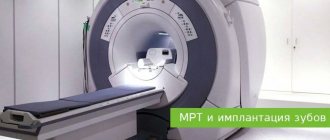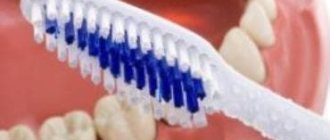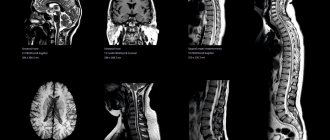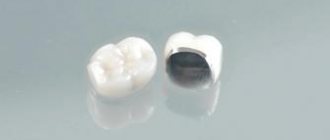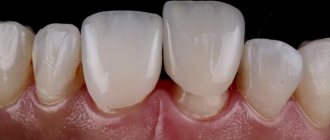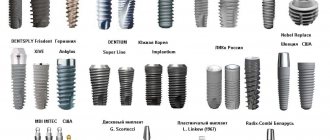Modern technologies in medicine make it possible to detect the slightest disturbances in the human body, but for this it is important to comply with all indications and contraindications for a specific procedure. Magnetic resonance imaging is one of these tests that can give an accurate picture of your condition. Before carrying out it, the specialist is obliged to collect a complete medical history of the patient, including regarding the presence of any metal structures in organs and teeth. This is required in order to obtain accurate data after the procedure. In some cases, the presence of metal becomes a contraindication to examination. You can find out below whether they are metal-ceramic crowns.
Features of MRI in human treatment
Magnetic resonance imaging is a relatively new method for diagnosing serious pathologies in the human body. Its essence lies in the effect of a special magnetic field on enzymes that are found in human tissues and mucous membranes. When conducting an examination, you must be extremely careful, since each organ is diagnosed using its own method.
This is due to the fact that each tissue of the system has its own number of hydrogen atoms. It is they, under the influence of a magnetic source, that make it possible to obtain information about the presence or absence of a problem. The tomograph picks up the received signals, and the doctor deciphers them. During diagnostics, it is important to remove all possible interference, which can be even small metal and metal-ceramic elements.
Attention! The procedure itself can take quite a long time, the average diagnostic time is 40 minutes. It all depends on the tissues that need to be assessed. If the patient is afraid of closed spaces, the diagnosis is carried out in an open apparatus.
What types of implants can MRI be used with?
Magnetic resonance imaging can be performed on patients with installed modern prostheses, as well as with bone implants made of paramagnetic alloys.
Important. Endoprostheses and fixators for osteosynthesis must be made of alloys or ceramics with low magnetic conductivity. This will avoid displacement of the implant, as well as its heating during the study.
Patients with hernia mesh, dentures, breast and joint endoprostheses can undergo MRI. Such implants are produced using non-magnetic materials. But before starting an MRI study, it is still better to consult a specialist.
When can you do an MRI with metal-ceramics?
About 5 years ago, any metal-ceramic crowns ceased to be a hindrance during magnetic resonance therapy. This is due to the fact that they are made from inert alloys. Such components do not interact in any way with the magnetic field, and therefore cannot come into resonance. This allows you to examine any organ of the body, including the head and jaw. There will not be even the slightest glare in the pictures.
But at the same time, it is necessary to pay attention to the alloys from which the fasteners for the crowns are made. In exceptional cases, they are made from alloys that give false results on MRI. But since the fasteners are small, they will not heat up much during diagnostics, which may make it possible to carry out the required examination. The problem can only arise when diagnosing the tissues of the jaw and teeth.
Attention! Since the patient cannot independently answer what metals are used in his design, the doctor will refer the patient to an orthodontist. The dentist must give an opinion on what alloys were used in the manufacture of the crowns. Based on the information received, a decision will be made on a possible examination.
Dental implants and brain MRI
Implantation of artificial teeth is a fairly common orthodontic procedure. This is a convenient and aesthetic way to replace lost teeth. Dental technologies for manufacturing implants are constantly being improved: outdated metal prostheses (made of iron and nickel) have been replaced by new materials. Titanium is the most commonly used metal in the manufacturing of implant mounts. It is inert to the magnetic field (does not heat up, is not attracted, does not magnetize), is not rejected by the body, and does not oxidize.
But, despite the relative “adequacy” of the reaction of paramagnetic substances to the effects of magnetic radiation, patients with dentures are not recommended to have an MRI of the head.
How does a patient with metal ceramics feel during the procedure?
During a diagnostic examination in the presence of metal-ceramic structures, the patient will not experience any discomfort, much less acute pain or other painful sensations. The patient's life is also in perfect order and nothing threatens her.
If for one reason or another you are denied an examination, this will be due to the fact that your metal-ceramic crowns will greatly distort the final result. This will happen due to the resonance of the metal elements of the dental structure and the magnetic field of the tomograph. As a result, the doctor will either not be able to see the tissues he needs, or marks will appear on them that will give a false diagnosis.
Attention! Patients with metal-ceramic crowns are often denied examination due to the high cost of MRI. Since it is difficult to predict the final result, some laboratories prefer to refuse treatment to the patient, especially when it is carried out on a budgetary basis, when it is not the patient who pays, but the clinic.
Contraindications to the procedure
If prostheses, pins and plates are firmly connected to the bone tissue and cannot move, then implants of other locations can easily move under the influence of a magnet. Therefore, it is STRICTLY PROHIBITED to conduct magnetic resonance imaging if they are present.
Implants that cannot be used for MRI:
- artificial heart valves;
- stents and clips on vessels of any location;
- middle or inner ear implants;
- pacemakers;
- artificial lens;
- Illizarov apparatus;
- insulin pump;
- large metal implants.
Minimally invasive endoprosthetics in the Czech Republic: doctors, rehabilitation, terms and prices.
Find out more
When is examination completely prohibited?
As mentioned above, regardless of when you had a metal-ceramic crown installed, a specialist will refer you to an orthodontist. This is required in order to find out what metal the teeth were made of. If the structure contains alloys such as iron, cobalt or nickel, the procedure is strictly prohibited. They interact very actively with the magnetic field, which can cause very sad consequences.
You can find them below.
- Due to resonance, the alloys identified above become very hot under the influence of magnets, which can lead to burns of the oral mucosa.
- When examining the heart and head, crowns may fly off, especially if there is poor contact with the main structure. The magnet will simply pull them out of their places, which can lead to painful shock and, accordingly, the need for urgent hospitalization.
- The crowns may move slightly out of place, which will require them to be re-fixed, which is quite expensive.
- An incorrect diagnosis will be made, which is especially dangerous if the presence of an oncological tumor is suspected. The initial stages of cancer are difficult to detect with other equipment.
If it is necessary to conduct an MRI examination, and the patient has complete contraindications, it is necessary to remove all metal-ceramic crowns that contain prohibited metal. Most often, such manipulations have to be undertaken if the patient suffers from severe pain in the jaw or teeth. During such examinations, it is necessary to remove the entire structure so that it allows identifying pathology.
Attention! Metal ceramics containing iron, cobalt and nickel are not a contraindication if you want to check the condition of the spinal region, abdominal systems and pelvic organs. In this case, they do not come into contact with the magnetic field in any way and do not distort the result. The procedure is absolutely safe.
Is it possible to do an MRI if there is a pin in the tooth or if you wear braces - MEDSI
Magnetic resonance imaging (MRI) is a type of examination of the body that is carried out using magnetic waves using a tomograph. The impulses sent by this device are reflected differently from each organ of the human body due to magnetic resonance. The result is a series of images of the organ under study from different sides and in different planes. Their detail helps the doctor make the diagnosis most accurately.
In what cases is this analysis used?
This study is necessary to identify problems with the spine, joints, brain, cardiovascular system, gastrointestinal tract and other organs. Thanks to it, it is possible to identify tumors, inflammation, and post-traumatic changes.
A doctor may prescribe an MRI in cases such as:
- Chronic headache, cramps, back pain, dizziness
- Determination of the state of the brain and the presence of pathologies in it
- Examination before or after surgery to monitor the patient's condition
- More accurate diagnosis after other tests
Application of tomograph in dentistry
In some cases, this testing may be required for problems such as:
- Pain and spasms when chewing
- Involuntary jaw movements
- Unusual sounds in the jaw
Is it possible to do an MRI of the brain if you have metal teeth?
Implants are placed in place of extracted teeth. They consist of a metal support and an artificial crown. Many patients who have undergone such surgery wonder whether the CT scan will harm them.
In this case, much depends on the metal from which the implant is made. Materials such as titanium and tantalum are inert and do not interact with the magnetic field and therefore do not distort the analysis result.
For implants made of ferromagnetic materials (alloys of gold, steel, etc.) there is a loose limitation for this analysis. It is due to the fact that these metals enter into a magnetic interaction with the tomograph. It will not harm the patient in any way. The problem is the image distortion that occurs due to this interaction.
What to do if you have metal teeth?
In the presence of non-inert metal implants, the use of magnetic resonance imaging of the head and chest is not recommended. For other organs, this analysis can be carried out - the tomogram is not distorted. If a head examination is needed and the patient has metal teeth, the doctor may order a CT scan or other test.
To prevent the patient from having to undergo an examination, the results of which may be useless or inaccurate, he should inform the doctor about the presence of metal implants and find out from the dentist exactly what material they are made of.
Is it possible to do the procedure with metal crowns?
Before performing an MRI of the brain, you need to remember about dental crowns. They are placed if the teeth are severely damaged and filling no longer helps. For their manufacture, metal, metal-ceramics and various alloys are used. Crowns made of copper-gold alloy or steel greatly influence the analysis results.
More modern crowns, for the manufacture of which inert metals and ceramic coating were used, do not affect the tomogram. Fasteners are made of cobalt, nickel or iron. They interact with the magnetic field, but do not heat up much and, due to their small size, do not affect the result of the study.
If the patient does not know what material his crowns are made of, he can contact the dentist to get a description of them.
Modern MEDSI equipment allows you to change its settings to avoid distortion of the tomogram. But only a doctor can determine how much this will help. If it is impossible to conduct an MRI of the brain due to metal crowns, he may prescribe another study.
Is it possible to do the procedure with a pin?
The pins are installed to securely fix the filling. Some patients are afraid to have an MRI of the brain if they have a pin in their tooth. They fear that the metal will heat up or be attracted to the magnet, destroying the jaw and other oral tissues.
Even if the pin is not made of inert materials (alloys of gold, steel, etc.), it does not deform the tissue around it and does not heat up much. But it will distort the tomogram of the head. Pins made of precious metals have the greatest impact on the results.
If a patient who needs an MRI of the brain has titanium, ceramic or gutta-percha pins in his teeth, then no problems will arise during the procedure.
To avoid distortion of the analysis results, before the procedure it is necessary to warn the doctor about the presence of the pin and make an appointment with the dentist to clarify the issue of its material.
How to do an MRI of the brain and keep braces?
Braces are placed to correct the bite and straighten the teeth. They can influence the results of the study only if they are made of non-inert materials. If they are titanium or polymer, then no reaction with the magnetic field will occur and there will be no interference on the tomogram.
Braces will have to be removed only if they are made of ferromagnetic materials (precious metals, steel alloys), and it is vitally important to conduct a tomography examination rather than a CT scan or other tests.
What do you need to get a procedure at MEDSI?
You must take one of two steps:
- Call and schedule a consultation or
- Contact one of twenty medical centers throughout Moscow
Here you will be met:
- Experienced radiologists of the highest qualification category
- Modern premium equipment that allows you to regulate voltage and neutralize interference
- Possibility of making an urgent tomogram in case of injury or sudden illness
What can replace MRI?
If a patient is contraindicated to undergo magnetic resonance imaging, and he does not want to remove metal-ceramic crowns, you can try to find an alternative. To do this, the following methods can be used, which can be found in the table.
| Procedure | Information content |
| Second place in terms of information content | |
| Relatively effective, sometimes requires confirmation with MRI | |
| Effective in some cases | |
| Not very informative, used only in combination | |
| It is advisable to use only in combination. |
Attention! Despite the possibility of using an alternative option, only magnetic resonance therapy can give the most accurate result, identifying even the slightest abnormalities that are not yet visible on ultrasound and any other tests.
Regardless of how many metal-ceramic crowns you have and what part of the body you are undergoing an MRI procedure for, you should always warn your doctor about the presence of a foreign body in your teeth.
If it is impossible to undergo an examination, the specialist will prescribe other procedures that can give an accurate picture of the state of health. If magnetic resonance imaging cannot be done, a computer diagnostic method is usually used.
How are crowns removed from teeth, indications?
In cases where the crown or bridge has moved during the MRI, they are removed and installed again or replaced with new prostheses. They do this in the following ways:
- sawing - the prosthesis is drilled out using drills with a cooling system; after removal, the structure is unsuitable for further use;
- ultrasound – ultrasonic waves destroy the cement, and the crown is easily removed from the stump;
- Koch apparatus - a special drill breaks the bond with gentle pushes, then the structure is lifted and removed;
- Coronaflex apparatus - compressed air is supplied under the edge of the prosthesis, this is the only method that eliminates damage to the structure and supporting teeth;
- special tools or sliding crown removers - used after destruction of the adhesive base using one of the above methods.
Orthopedic structures are also removed in case of resorption of cement, chips of ceramic lining, damage to the frame, inflammatory processes in the root canals, or the patient’s desire to replace the prosthesis with a better one.
It doesn't hurt to remove crowns
Is it possible to shoot on your own?
Sometimes the bridge or crown is so loose that the patient can tear it off himself. However, this should not be done, because... possible:
- damage to the prosthesis;
- fracture of the stump or root system of the tooth;
- traumatization of the mucous membrane or adjacent units.
If the denture becomes loose, the only correct option is to contact a dental clinic.
Does it hurt?
Removing dentures does not hurt at all, unless, of course, the patient rips them off himself. Because crowns and bridges are placed on already decayed teeth; in most units the pulp has been removed. Therefore, unpleasant sensations are excluded. There may only be a feeling of pressure on the jaw.
If the tooth under the crown is not pulpless or its roots are inflamed, dentures are not removed. The doctor administers anesthesia to eliminate pain.
How long does the procedure take?
The duration of prosthesis removal depends on the method. So, using a cut, the structure is removed in 10-15 minutes. But preliminary decementing of crowns using ultrasound, a Koch or Coronaflex apparatus can take several visits.
Artificial teeth are not an obstacle to magnetic resonance imaging. Modern designs are made from bioinert materials that do not harm the patient and do not affect the examination. If there is one of the items prohibited for examination in the mouth, it is removed and then fixed again.
Where to get an MRI in Moscow?
What should you do if doctors in your city refuse to examine you at the mere mention of prostheses and plates?
Don't worry about it. On the website MRT-kliniki.ru you can choose any clinic in Moscow with good specialists who know all the nuances of performing tomography for “problem” patients. This site will help you not only choose the best diagnostic center, but also find out the cost of services. This is also an important point, because the price of an MRI in Moscow in one clinic can be 2-3 times higher than another. Therefore, it is worth comparing the cost and choosing a medical institution with a loyal pricing policy. * - organizations banned in Russia.
Possible complications and precautions
MRI in the presence of electronic implants can seriously harm a person or even lead to his death. Performing the study on persons with coronary walls and clips on cerebral vessels can provoke massive bleeding, which will lead to death. Endoprostheses made from some alloys may move out of place or heat up during an MRI, causing burns.
MRI installation before the procedure.
People with certain types of implants are strictly prohibited from undergoing magnetic resonance imaging. But for patients with implants made of “dangerous” alloys, you can still try to perform the study. As a precaution, a button is placed in the person's hand. If he feels a strong burning sensation, he presses it and the study is stopped.
Fact! Metal prostheses tend to “fade”, making the image of nearby tissues unclear. Therefore, it is pointless to try to obtain an MRI image of the replaced joint or bone held together by fonts or plates.
How does MRI work?
Let's figure out what a magnetic resonance imaging scanner is and how it works. This device is designed for targeted examination of tissues and blood vessels of the body. Modern devices with a power of 1.5-3 Tesla are capable of identifying problem areas smaller than 0.2 mm. The principle of operation is based on radio waves and the magnetization properties of the nuclei of hydrogen atoms, which are located everywhere in the body (and we remember that a person is 70% water).
The nuclei of hydrogen atoms “respond” to a powerful magnet (enter into resonance), and a special program records a picture and displays it on a computer. The diagnostic result consists of many virtual sections or sections of the desired organ - the brain or spinal cord, liver, vascular system, etc. And the radiologist makes a written report on the data obtained.
%akc54%
In general, there are two types of tomographs that are installed in specialized institutions - a cone-beam tomograph (CT) and an MRI machine itself. The first, even with implants, does not distort the image, but is also not suitable for studying small areas (for example, brain tumors). During an MRI, a magnet may cause some image distortion in the area of metal products in the body - but whether implants are included in this list will be discussed later.
On a note! Tomographs are also available in dentistry - they are less powerful and give a much worse picture (however, for the needs of the clinic this is enough). Neither the presence of implants nor the presence of metal crowns is a contraindication to this study. However, such devices are cone-beam and do not contain magnets.
